Winter squashes take time to mature, and most varieties have a tough outer rind that protects the fruit inside from the cold. Unlike summer squash, winter squash is harvested and eaten when the fruit is in the mature stage. Once mature, the fruit can be stored for use throughout the year.
However, there are many varieties of winter squash. The squash comes in different textures, colors, and shapes. Some like butternut are popular in our kitchens, while others like Kabocha are an exotic variety.
Read on as we list some of the winter squash varieties available and their characteristics.
Table of Contents
21 Types of Winter Squash
Some of the winter squash varieties are:
1. Butternut Squash

The butternut squash is the market’s most popular type of winter squash. It gets its name from the shape that resembles a peanut.
You’ll recognize butternut squash due to its bright orange flesh and beige-colored skin. Butternut has a tiny seed cavity and its flesh is dense.
If you’re looking for a versatile squash, you’ll love butternut as you can roast it, make soups, and even sauté it. Most people love butternut’s sweet and nutty flavor. It’s also simple to peel compared to a regular pumpkin and other winter varieties.
Ensure that you get firm butternut free of soft spots or cracks for your recipes.
2. Acorn Squash

Although butternut now seems like the most popular squash, you’ll be surprised to know that acorn squash is also commonly used in the U.S.
The squash has deep grooves from the stem to its tip. It has a round shape and a green exterior with orange spots. Most people love its tasty and tender flesh.
You can use the acorn squash for baking, roasting, mashing, steaming, and sauté. It’s perfect for anyone trying out new recipes without using a lot of squash. The small-sized squash can serve at least two people and is also easy to slice.
You’ll love the starchy but sweet flavor.
There’s also a gold acorn with an oval shape and small-to-medium size. It gets its color from the bright yellow skin. Like the regular acorn, the golden acorn can also be used for streaming, baking, roasting, grilling, and stuffing.
3. Kabocha
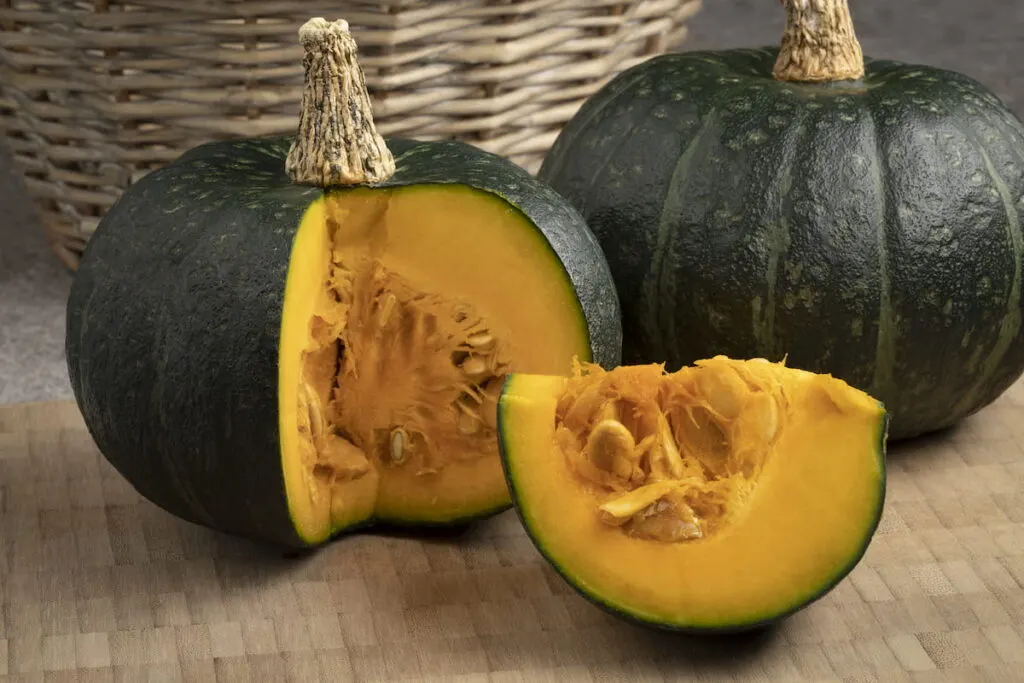
Kabocha squash has a round shape and a flat bottom. Its exterior is light green, while its interior is a bright orange or a pale-yellow color.
Unlike other winter squash varieties, kabocha squash has a rich pumpkin taste, and some people consider them small pumpkins. The squash’s skin and fruit are edible.
You can pair kabocha with a glaze or eat it on its own. It can also be used for baking and roasting. In Asian cuisine, kabocha is fried in tempura butter or pureed into squash curries or soups.
4. Delicata
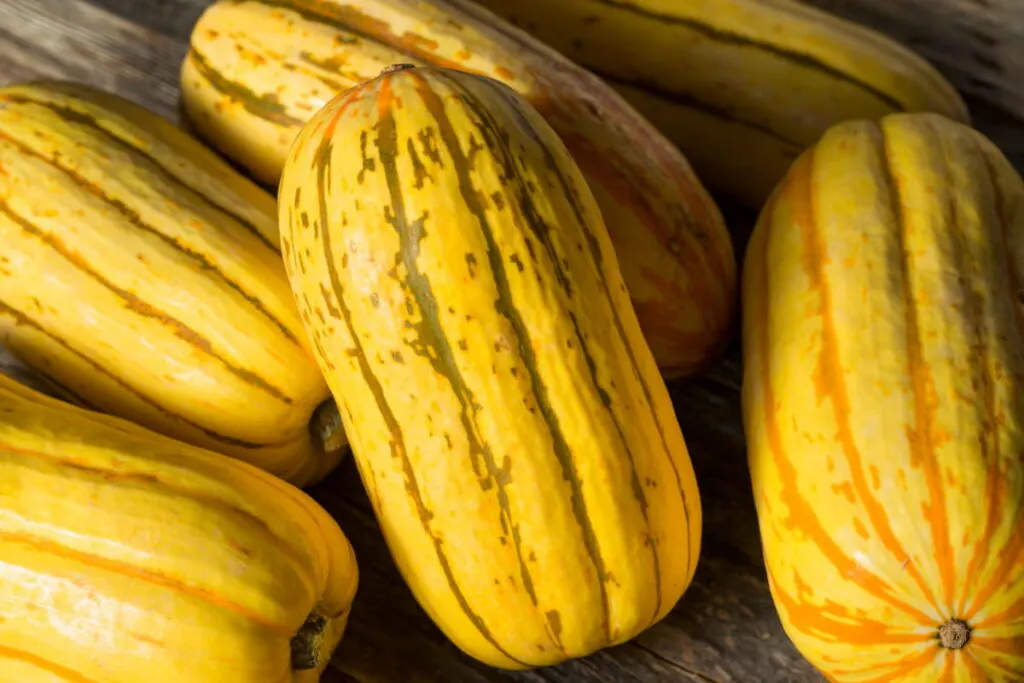
Delicata squash has an oval shape and a light-yellow color with green stripes. The squash matures from September to December.
Some people also refer to delicata squash as sweet potato squash due to its sweet taste.
Additionally, the squash’s outer skin is edible, and you don’t have to peel it when incorporating it into your recipes.
You can use delicata squash for baking, roasting, or as stuffing.
5. Sweet Dumpling
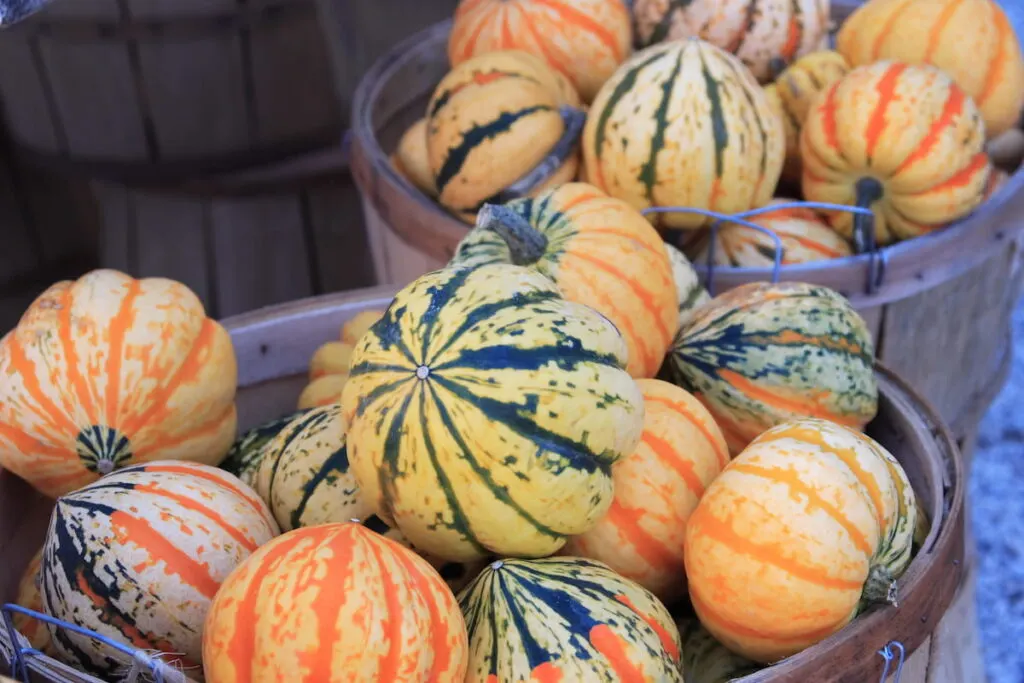
The sweet dumpling squash has a colorful pale yellow/green color and a tough rind. It has a sweet taste like a sweet potato.
You can roast it and stuff it as a side dish. Some people also puree it with butter or serve it with a glaze.
6. Buttercup
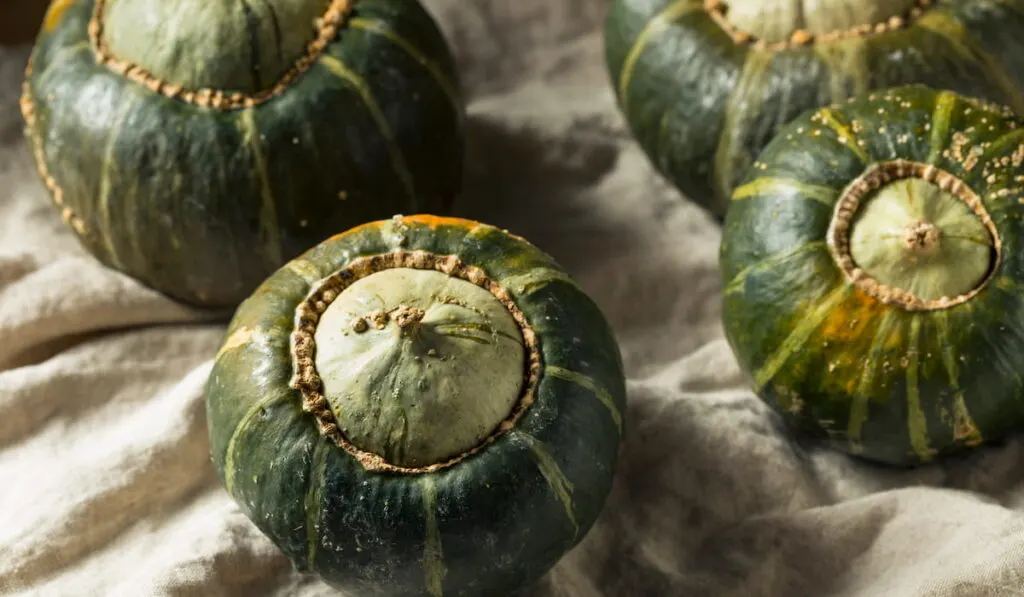
Buttercup squash has a dark green color and light green stripes. Apart from the color, the squash has a round ridge at the bottom.
Its interior has a bright orange color. Buttercup squash has a mild flavor sweeter than most winter squash varieties.
You can use buttercup for baking, steaming, and stews.
Unlike some varieties with edible skin, buttercup squash has tough, inedible skin that can be challenging to peel. Baking it softens the skin and allows you to peel it or scoop out the flesh.
7. Hubbard
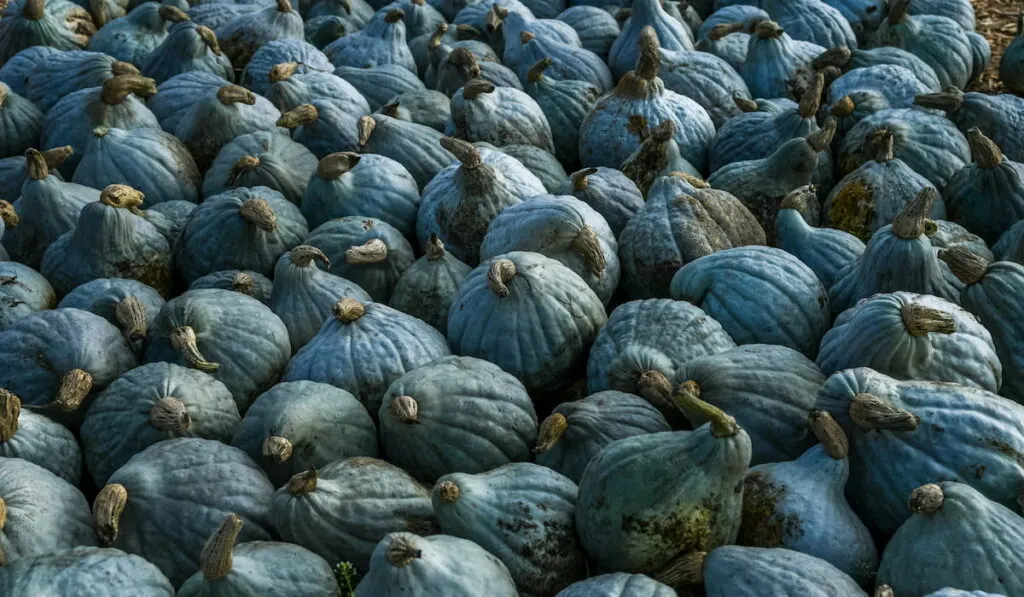
Hubbard squash has a grey-blue exterior and a lumpy texture. It‘s one of the largest winter squash varieties with a bright orange interior.
The squash has a nutty, earthy flavor, which makes it an excellent base for adding spices and roasting.
8. Spaghetti Squash
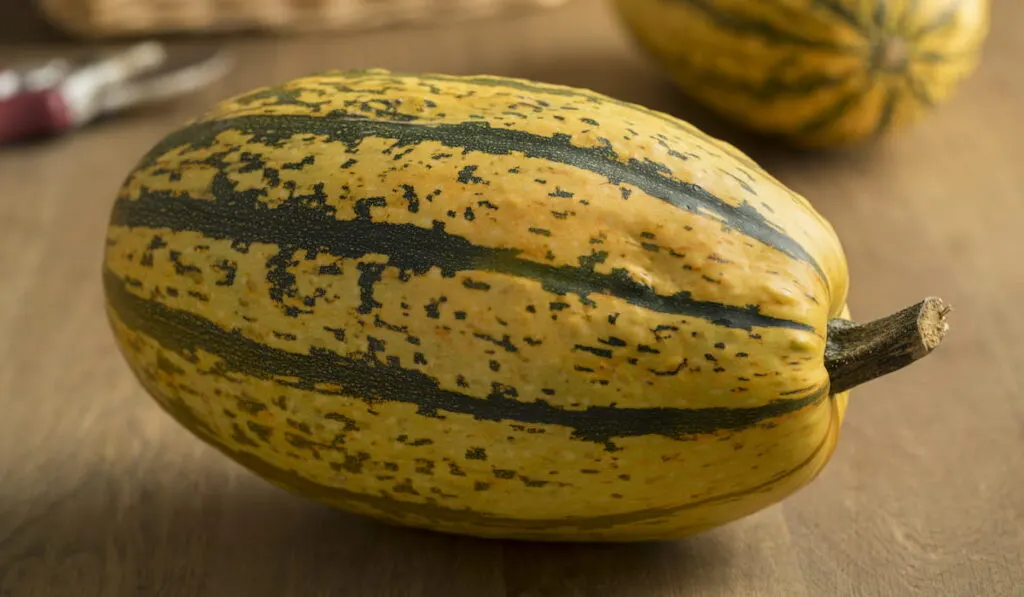
Spaghetti squash gets its name from its interior. Its stringy flesh resembles spaghetti. Apart from its stringy interior, the squash has a pale orange exterior and an oval shape.
You’ll love the squash’s mild flavor and crunchy texture. A starchy and fibrous variety makes spaghetti squash a good variety for roasting.
9. Red Kuri

Red Kuri or the orange Hokkaido squash is another Japanese squash variety, The word Kuri is a Japanese word for chestnut.
It features thin skin and has a round shape that looks like a pumpkin without ridges. The interior has an orange skin that is firm yet soft.
You can use Red Kuri in your baked goods, sautés, as a stuffing, or simmer it in stews and soups. The squash has a silky texture, which makes it a great addition to soups.
10. Turban Squash

Turban squash resembles a turban with a bumpy top, like a small hat and an uneven shape. It’s also medium to large.
The squash’s nutty and sweet flavor is unique, making it perfect for stews, curries, soups, and baked items.
11. Honeynut Squash
Honeynut squash has a bell-bottomed shape with a pale orange exterior color.
The squash grows between September and April and is one of the genetically modified squashes with a concentrated butternut flavor.
12. Pink Banana Squash
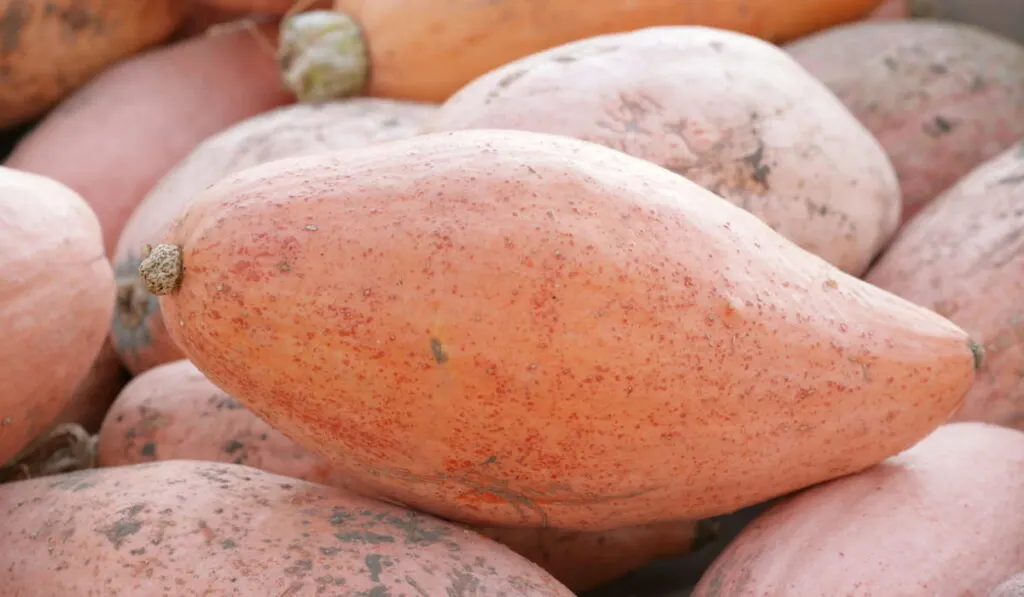
The pink banana squash features a bright orange exterior and a pink exterior. It also has an oval shape.
Unlike some versatile squashes, the pink banana squash can only be pureed due to its starchy and creamy texture.
13. Carnival
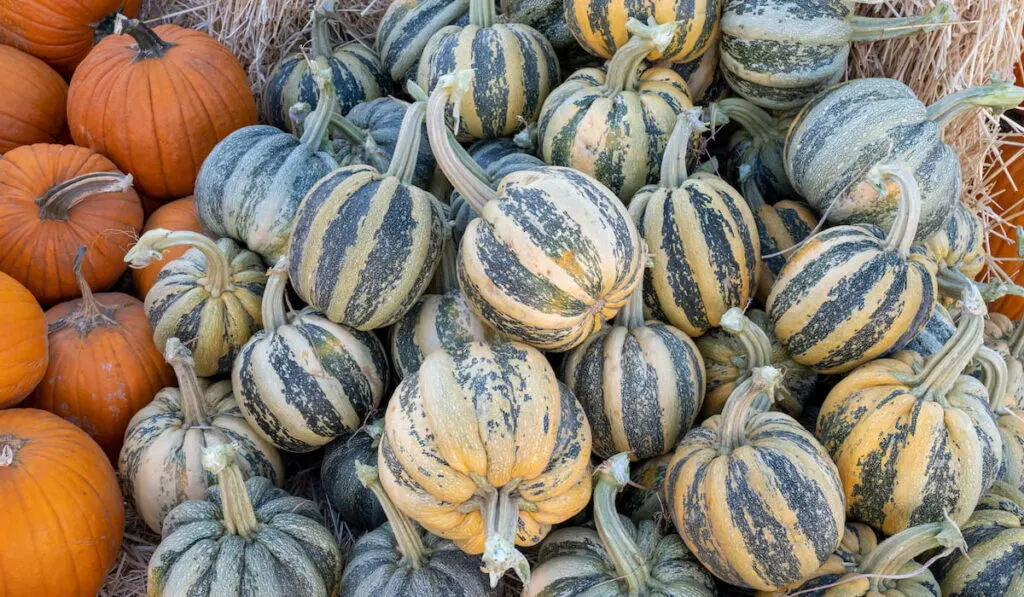
Carnival squash is a cross between sweet dumplings and acorns. The small squash has multicolored stripes and spots, which makes it unique and easily identifiable.
Its light orange flesh is edible. You’ll love the squash’s sweet and nutty flavor.
14. Banana Squash
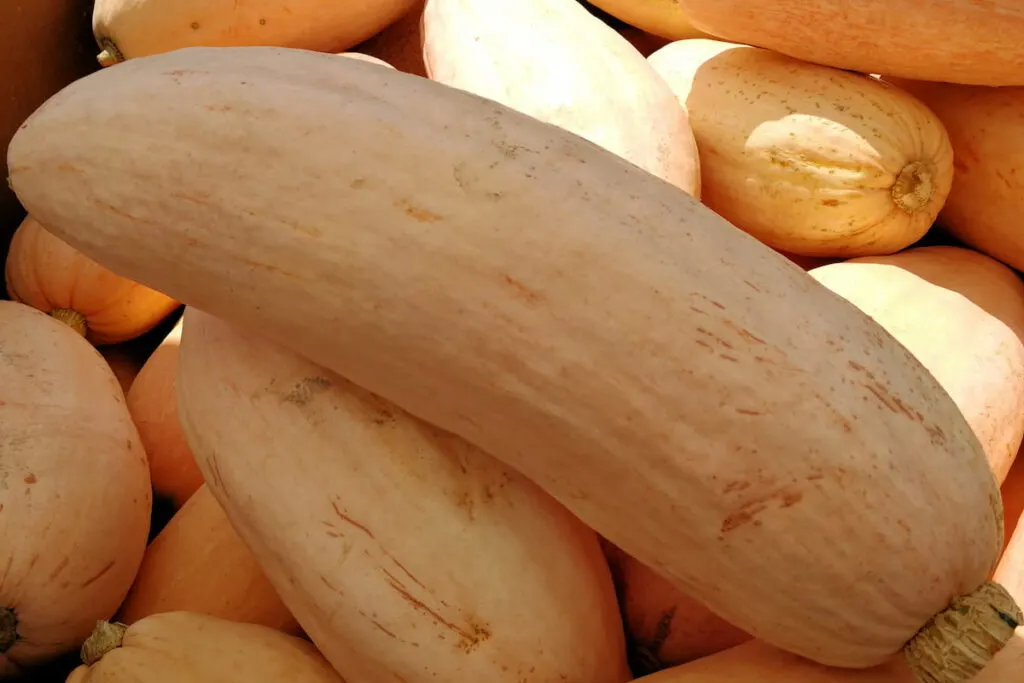
Banana squash has orange skin and vibrant orange flesh. It resembles a banana with its long-elongated shape.
The large squash can weigh up to 30 pounds and is sometimes sold as pre-cut chunks. You’ll love the banana squash’s bold and rich flavors, which make it perfect for soups, stews, and roasting.
15. Sugar Pumpkin
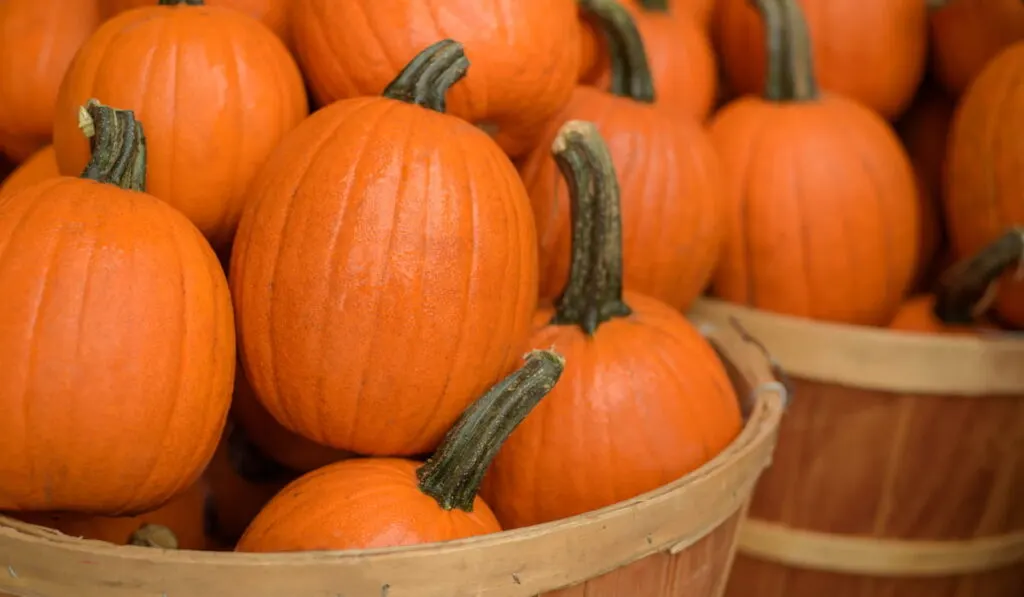
Sugar pumpkin or pie pumpkin is a large variety of pumpkins.
Although they look similar to pumpkins carved for Halloween, these are different as they are small and have a round shape. They also have bright-orange flesh.
You can use sugar pumpkin to make pies. It’s also perfect for curries and soups due to its fibrous and bold flavors.
16. Cheese Pumpkins
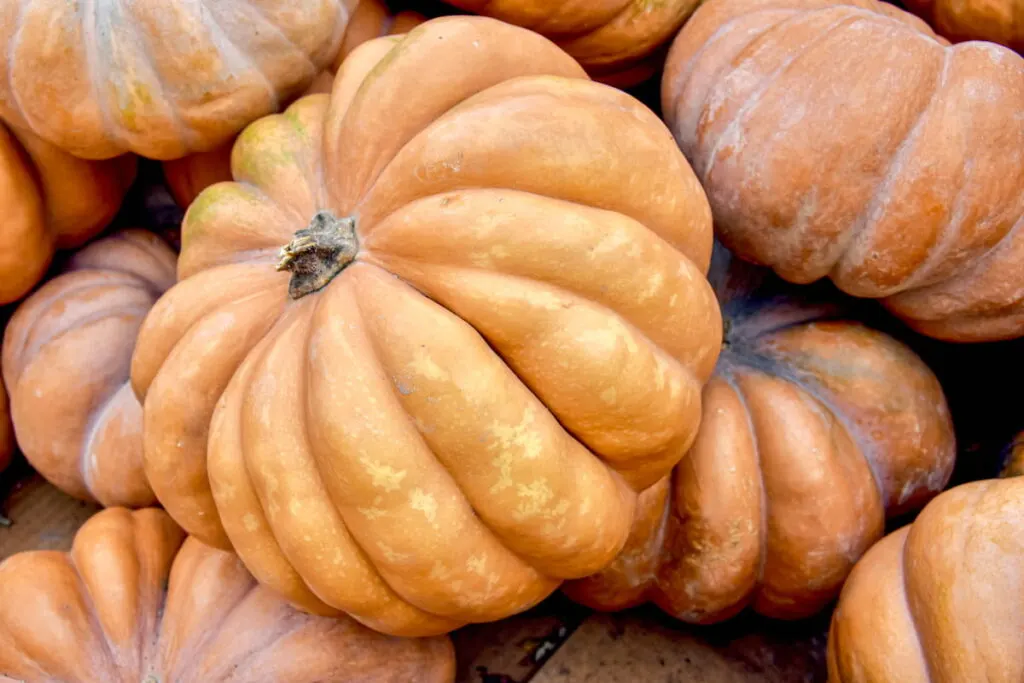
Cheese pumpkins are one of the oldest varieties in the U.S.
The pumpkin has a firm, but sweet flesh, making it ideal for roasting. Another unique aspect is that the pumpkin’s seeds and skin are edible.
You can steam, boil, bake, and grill cheese pumpkin.
17. Angel Hair
Angel Hair is a type of spaghetti squash. It has a dark yellow rind surrounding the light-yellow flesh with strands that look like spaghetti.
The squash has a crisp but mild flesh. It’s ideal for roasting.
18. Pumpkin
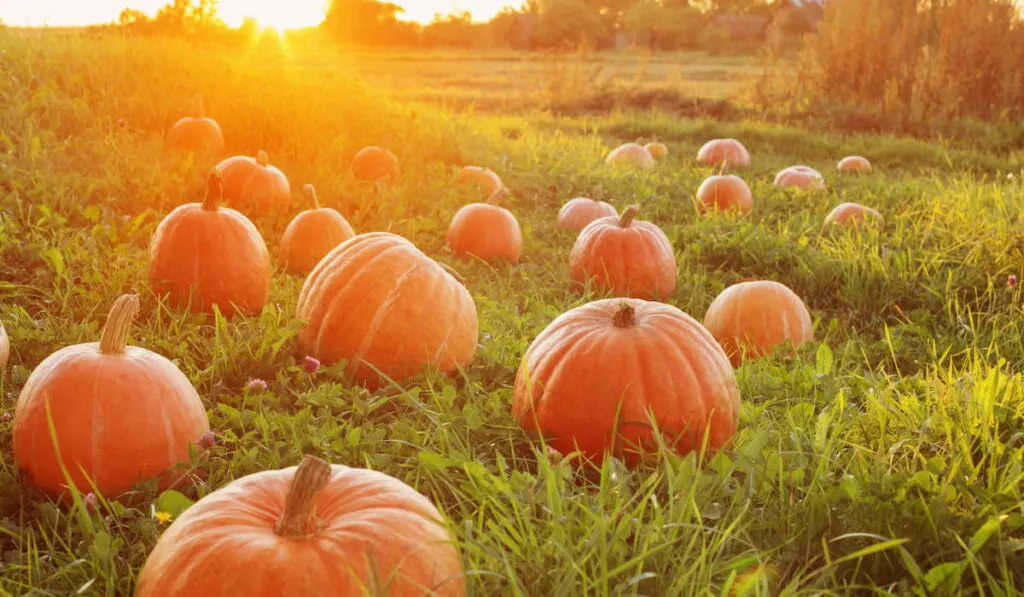
Pumpkin is another type of winter squash. It has a firm and round exterior that is pale to bright orange. The interior is also bright orange and is mainly used for baking and cooking.
You can also add it to curries, soup, and pies apart from roasting it.
19. White Pumpkin
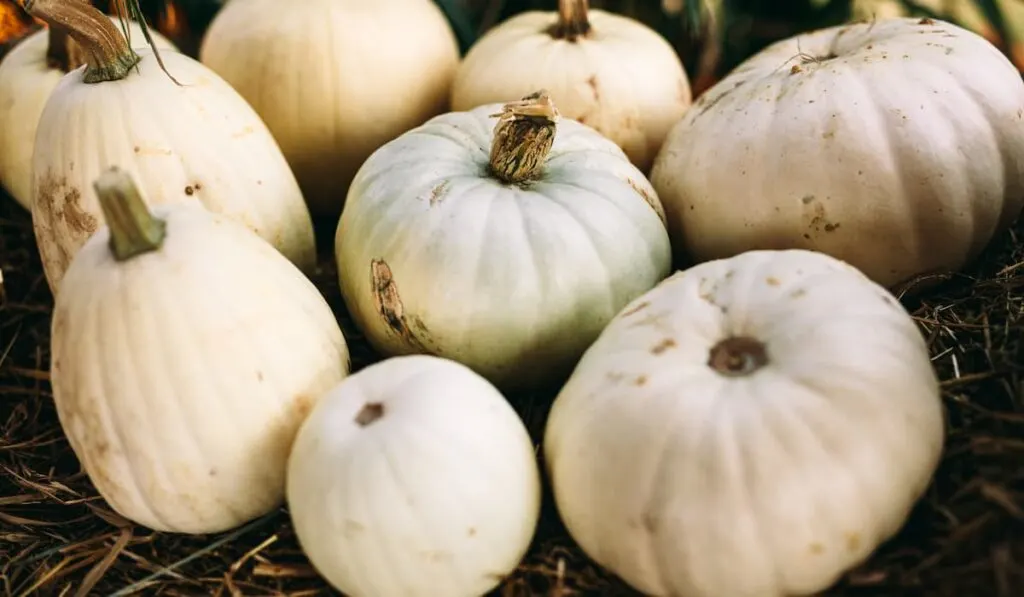
White pumpkins have a bright white exterior and are also known as snowballs or ghost pumpkins.
The squash has dark orange flesh. You’ll see most white pumpkins being used as a Halloween decoration. They can also be used to make soups and bake pies.
20. Black Futsu
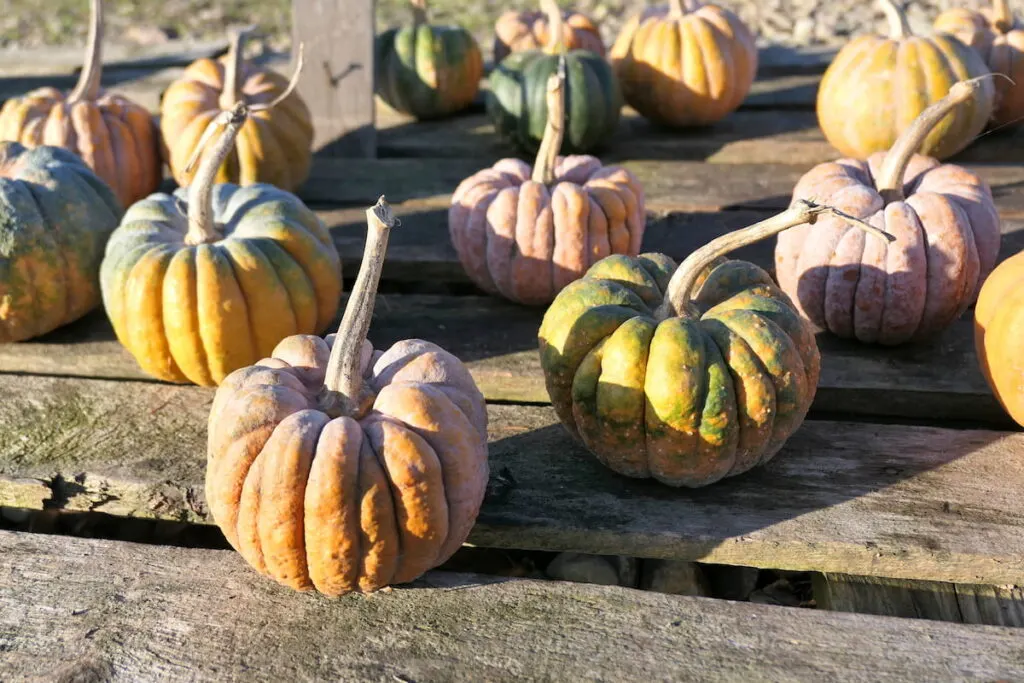
Black futsu are small types of squashes with rough and ridged exteriors. They turn from a pitch-dark green color to a dusty clay orange color when they are ready to eat.
The skin of black futsu is soft, and the flesh has a velvety texture and is creamy. Its flavor has hints of pumpkin and chestnut.
21. Jarrahdale Pumpkin
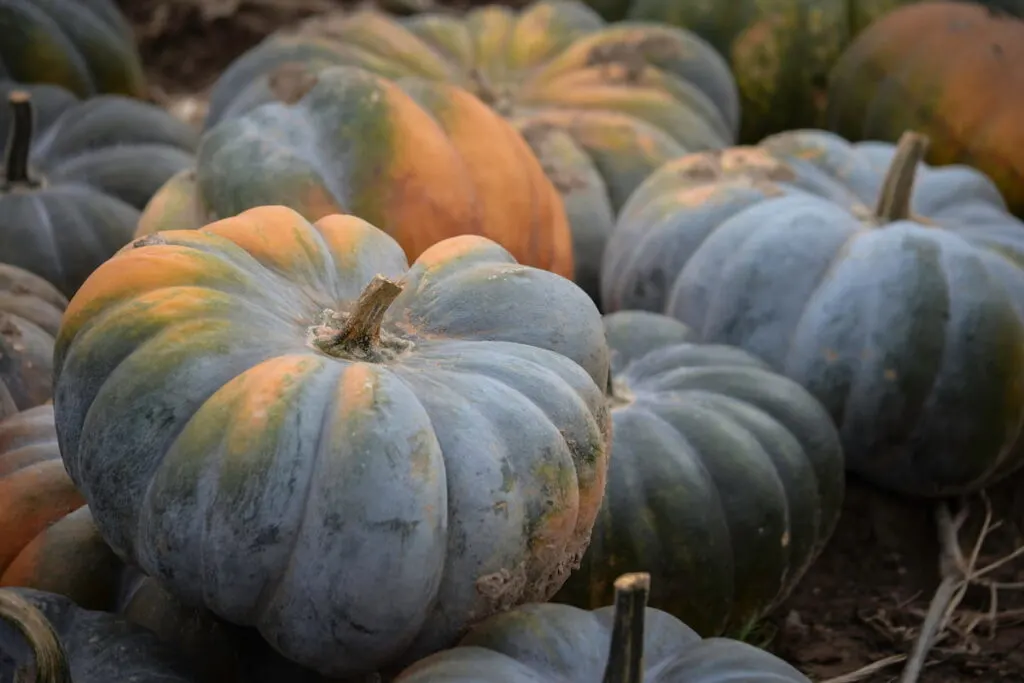
Jarrahale pumpkin has a grey-greenish color and is widely used for decorations. Its interior has a bright orange color and is sweet like that of a butternut.
You can add it to your savory and sweet dishes.
Final Thoughts
Winter squashes are rich in dietary fiber, vitamins, folate, and antioxidants. Most varieties can be steamed, baked, sautéed, and even pureed into soups and curries.
Additionally, these squashes have a long shelf life if stored properly. Apart from the popular butternut, you have other varieties that you can try, thanks to their assorted flavors and textures.
Resources
- https://spoonuniversity.com/lifestyle/5-types-of-winter-squash-what-to-make-with-them
- https://www.insider.com/guides/kitchen/types-of-squash
- https://web.extension.illinois.edu/veggies/wsquash.cfm
- https://www.tasteofhome.com/article/winter-squash-101-acorn-beyond/
- https://www.epicurious.com/ingredients/a-visual-guide-to-winter-squash-varieties-article
- https://www.allrecipes.com/article/types-of-winter-squash/
- https://www.thekitchn.com/the-11-varieties-of-winter-squash-you-need-to-know-ingredient-intelligence-157857
- https://www.gardeningknowhow.com/edible/vegetables/squash/winter-squash-varieties.htm
- https://www.insider.com/guides/kitchen/types-of-squash
